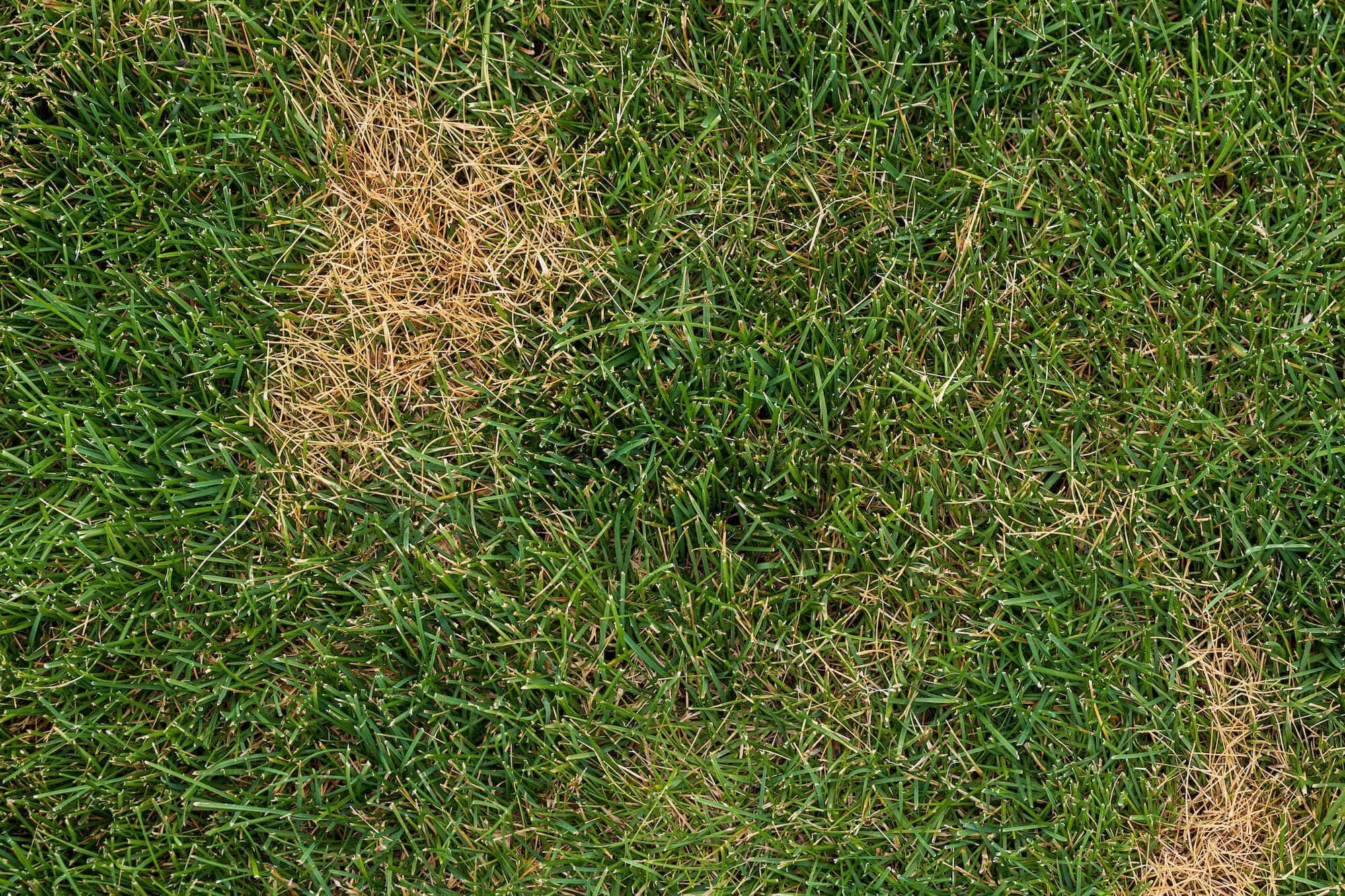What Causes Brown Spots in Your Grass?
Spotting that dreaded brown patch in your lawn can be incredibly frustrating, especially if you’re not sure how it got there in the first place. Even when you work diligently to keep your grass healthy, brown spots have a way of creeping up when you least expect them.
Luckily, brown and yellow spots on your lawn can stem from a wide range of standard problems, nearly all of which are easily fixable. By quickly adjusting your lawn care plan or addressing the culprit, green grass will soon take the place of the brown or yellow spot in just a few weeks.
In this guide, we’ll help you identify why you’re finding brown or yellow spots of grass in your lawn and how to get your landscape looking lush and green again in no time. When in doubt, however, a professional lawn care team is often the quickest and most cost-efficient answer to maintain a year-round lush landscape.

Common Causes of Patchy Lawns
A large percentage of brown spots are caused by some form of fungus or grass disease that can break down and discolor the grass quite quickly. In other cases, too much water, sunlight, soil compaction, or pests lead to the telltale rings and dots of off-color grass.
Top Reasons for Brown Spots
- Overgrown thatch
- Grubs
- Disease and fungus
- Soil compaction
- Dog urine spots
- Poor soil pH
- Seasonality
- Mowing Errors
- Erosion
Overgrown Thatch
If you get down at the ground level, take a look at the layer between your soil and the tips of the grass. You’ll likely be able to spot a thin layer of twisted roots, soil, grass, and grit before the dense soil layer begins.
How Does Thatch Cause Brown Spots?
A layer of thatch on your lawn is completely normal when it stays between a half of an inch throughout the season. Any larger, and water, sun, air, and nutrients may be unable to permeate this wall to get to the roots and soil of your lawn.
Overgrown thatch can occur for a range of reasons mainly stemming from an imbalance in the natural ecosystem of your landscape. Overfertilization, too much water, bad soil pH, and soil compaction can break down the population of microorganisms that naturally cycle through your thatch.
Checking for Overgrown Thatch
Either on your own or with the help of a professional landscaper, remove a small cross-section of grass from the edge of your brown spot and measure the layer of thatch. If the thatch measures normally, keep the piece of lawn for more tests.
Fixing Overgrown Thatch
If your thatch layer has led to brown or yellow spots in your lawn, use a dethatching rake or vertical mower to break up the grass in that area. The machine will remove small cores of grass, thatch, and soil from your lawn, allowing nutrients to permeate once more.
In addition to troubleshooting with the detaching process, it can be helpful to detach once in the spring and one more in the fall for a healthy landscape. Speak with your local TruGreen specialist for detaching care to simplify the process.
Grubs
A moist lawn is an ideal place for grubs to hide out when the weather starts to warm up. Grubs are the small white larvae of Japanese beetles that feed on grassroots. You may have grubs if proper fertilization and watering fail to perk up the brown spots in your lawn.
How to Check for Grubs
Delicately remove or lift up a small top layer from your lawn—about one square foot—and count any visible grubs in the soil below. While the presence of some grubs is standard, more than nine in one square foot is a sign of an infestation.
Natural Grub Treatment
There are several natural tactics for getting rid of grubs, such as by encouraging natural predators or treating them with the bacteria milky spore. You can also perform standard grub treatment at the start of the season, typically in late spring.
Disease and Fungus
A disease known as Brown Patch is the most common reason for off-colored grass. Some of these may include:
- Rhizoctonia causes both Brown Patch or Large Patch, both of which stem from a fungus that causes a smoky-white ring around the patch.
- Red Thread is more common in the Northwest regions, particularly in cool-season grasses. This is easy to spot due to the red grass poking through your green lawn.
- Rust Disease also stems from a fungal overgrowth that leads to patches of yellow-green areas that have a red, rust-like tint when viewed up close.
Preventing Disease and Fungus
The majority of fungi on this list can be avoided by maintaining a balanced and healthy lawn. Overall, you can accomplish this by:
- Restricting your water to one inch per week and by avoiding your soil from becoming oversaturated.
- In the hotter months, only water in the early morning or late afternoon to give the lawn time to dry out before nightfall.
- Be aware of overfertilization, especially with nitrogen-heavy mixtures. Speak with a TruGreen professional about choosing the right natural fertilizer for your grass variety.
- Ensure your lawn is dethatched and aerated for proper drainage.
- Follow mowing recommendation for the season and grass variety. Be sure to remove clippings after your mow if you’re concerned you may have a fungus. This helps avoid spreading it to other areas.
Treating Lawn Fungus
If these basic intervention practices do not cut off the fungus at the pass, you may need to use chemical fungicides to treat the small area. Most fungicides will control the growth for several weeks, in which time, you can adjust your approach to lawn treatment and let the grass grow back.
Soil Compaction
Too much foot traffic or larger materials pushing down on your grass can lead to what’s known as soil compaction. When the soil becomes too dense, root growth is hindered and both air and water cannot permeate the ground as much as it needs to.
Common causes of soil compaction include:
- Vehicle traffic or heavy mowers
- Seating, playground, or decorative items
- Constant foot traffic
- Dense local soil
Address overly compacted soil by both removing the items causing the extra pressure and by aerating the soil to restore moisture and sunlight balance to the area.
Dog Urine Spots
In some cases, the simplest answer is often the best one. Before digging up your lawn to check for grubs, thatch, or fungus, double-check that your patches are not coming from a neighborhood dog.
Pet urine is high in nitrogen, which can kill grass when used as a pee spot on the same walk every day.
Will Damaged Grass Grow Back in Urine Spots?
In the majority of cases, your grass will grow back on its own in spots that have been damaged by a pet or passing dog. However, if the habit continues, it may not have the chance to grow back strong in the long run. The most useful fix is to stop the habit.
Poor Soil pH
In severe cases of soil pH imbalances, brown or yellow spots can form on your lawn as well. As we mentioned above, this issue can stem from culprits like fungus, poor fertilization, or incorrect watering practices.
Testing Your Soil pH
Store-bought soil tests are a quick and easy way to test your lawn’s pH, but your TruGreen lawn care team can include the pH test in their process as well.
The ideal pH should fall between 6.5 and 7. Depending on the makeup of your region’s soil, you may need to balance out the alkaline properties for healthy grass. Speak with a professional to adjust the levels of iron and sulfur in your lawn while avoiding over-fertilization that can exacerbate the issue.
Seasonality
It’s important to note that warm-season grasses naturally turn brown during their dormancy period in the winter. These may include St. Augustine grass, carpet grass, or Bermudagrass. If this is your first season working with a lawn or newly planted landscape, wait for the warm weather to return for that green look.
If you believe that the wrong variety of grass has been planted in your lawn for your region, speak with a lawn care expert about how to adjust your routine to care for its needs.
Mowing Errors
Think of your grass like any other plant that benefits from the right form of pruning. Be sure to always sharpen your blades at the start of the season to ensure a clean cut off the top of the grass. Dull mower blades can inadvertently tear the grass, damaging its health and killing patches over time.
You are more likely to see this issue spread across larger portions of your lawn, as opposed to in small spots or patches.
It is always important to adjust your mower blades depending on the season as well. Allow your grass to grow higher in the warmer months and cut it closer to the ground before the cold season.
Erosion and Sloped Properties
Extreme weather or steeply graded landscapes can pose a unique challenge to lawns, especially around the edges of your property. Rain and wind can slowly cause your soil and grass to erode over time, uprooting your grass and leading to brown or yellow patches of dead grass.
Addressing Sloped Lawns
Maintaining the right balance of moisture in your soil can provide the strength it needs to fight against the pull of erosion. Aerate your lawn more frequently to ensure that water is property reaching deep into the soil to strengthen its roots.
Diagnosing Brown Spots
So, how do you rule out possible causes to quickly and properly adjust your lawn care plan and ensure the grass can safely grow back?
We recommend starting with the least-invasive and easy-to-diagnose issues, such as pet urine, seasonality issues, and mowing problems. These tend to be easier to spot since the dead spots of grass will occur in the same patterns over and over.
If there is not a clear pattern to the patches, it may be time to test a piece of soil and investigate the health of the grass itself. Rule out pH issues, grubs, and fungus.
Still coming up without an answer? Shifting your basic lawn care regimen may be the simple key to a green lawn in the long run. Speak with a professional about your common lawn care habits to get to the bottom of the issue.
Professional Help for Brown Spots in Your Lawn
The long list of factors that affect the health of your lawn can be overwhelming, especially when you’re battling dried brown or yellow spots that won’t go away. TruGreen’s local teams can offer personalized assistance to get to the bottom of what’s plaguing your landscape.
TruGreen’s annual maintenance plans provide lawn health analyses, aeration, fertilization, as well as pest and weed control. With a professional team on your side, the occasional brown spot can be addressed by an expert eye without delay.
With local experts across the country, TruGreen offers eco-conscious, affordable lawn care services that can both diagnose common problems and maintain healthy lawns throughout the year. Reach out to a specialist in your area today for a free assessment and plan for the brown spots of your lawn.







